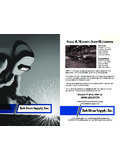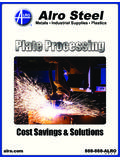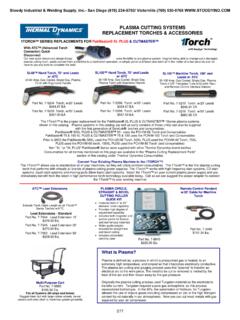Transcription of Operation Manual - Kyndill Control
1 1 Operation Manual 2 Table of Contents Contents ITEMS CHECK LIST .. 3 WARNINGS .. 4 System Requirements .. 4 Principles of Operation .. 5 First, some theory on how this all works .. 5 AVHC Installation .. 6 Raw ARC Voltage Connections .. 7 CNC Start Relay Connection .. 8 Optional Connections .. 8 Membrane Button Operation .. 9 Special Key Combinations .. 9 Menu Parameter Description/Navigation .. 10 Loading and Saving Profiles .. 12 Operation .. 13 SETTING ARC START DELAY .. 14 SETTING PIERCE HEIGHT .. 14 SETTING THE DWELL TIMING (without Pierce Complete) .. 14 SETTING CUT VOLTAGE .. 15 Manual / AUTOMATIC MODES .. 15 CUT Button .. 16 LIFTER STATION 17 ELECTRICAL SPECIFICATIONS .. 18 Warranty .. 18 Troubleshooting .. 19 3 ITEMS CHECK LIST Your new AVHC system should include the following items.
2 Please check each item has been included and is free from damage. A. (1) (AVHC) Arc Voltage Height Control Box B. (1) Magnetic Breakaway Lifter Station - Motor Preprogrammed w/ latest software C. (1) 50 Communications/Power Cable D. (1) 6 AC Power Cord E. (1) 50 Breakaway Cable F. (1) Mounting Plate (pre-attached to lifter station) G. (1) Hardware 5/16 -18 x Socket Head Screws with washers (x2) Input Connector Kit: (1) 10ft Fault Cable (1) 10ft Pierce Cable (1) Breakaway Adapter Cable (1) CNC Input Connector (not pictured) (1) Setup Guides and Tips Magnet (placed on side of controller) (1) Special Key Combination Magnet (placed on top of controller) (1) Raw Arc Voltage Cable, 20 2 Conductor 18 AWG (not pictured) (1) Relay/Start Cable, 10 2 Conductor 18 AWG (not pictured) A B C D E F G 4 WARNINGS When working on or maintaining your plasma cutting system, be sure to disconnect all power sources.
3 High voltages and amperages are present and can be fatal. For arc voltage interface installation follow manufacturer s instructions carefully. Always follow all plasma system manufacturers safety precautions. These cautions also apply to the height controller system. While the Torch height Control can dramatically reduce the dependency of human intervention in the cutting process, never leave the machine unattended while cutting . Parts may tip-up after being cut and interfere with machine travel. plasma cutting systems produce high EMI (electromagnetic interference) which can cause unpredictable electronic system effects and Operation . To reduce the potential of interference, always separate the Control cables from the plasma torch cable by at least 6 inches where possible.
4 The work clamp, or ground wire, should always be attached to the material you are cutting . This will ensure that the electricity needed to cut through the material is flowing from the Torch tip (Negative charge) to the work clamp (Positive charge) in a path of least resistance. FYI: Clamping your work lead in close proximity to the section of material being cut will ensure proper connectivity. NOTE: Attaching the work clamp to the table can cause this electricity to flow through other components of the table, such as the motors, and cause internal damage. System Requirements Your plasma system must have an available output for raw arc voltage. Raw arc voltage is equal to the actual cutting voltage and is not conditioned by a voltage divider to reduce the sensing voltage.
5 Your plasma system must have two wires that can be used to initiate plasma cutting by connecting these two wires together with either a switch or relay contact with a load no greater than 2 amps. The Kyndill Controller has a relay internally to accomplish this task. If your plasma requires more than a 2 amp signal, an external relay can be added. Use supplied 20 18 gauge cable for your raw arc voltage connection. Your CNC system must have an output relay that can be used to initiate the cutting sequence. A normally open contact rated at 1 amp that closes at the start of cut sequence will suffice. Use supplied 10 18 gauge cable to connect the relay to the AVHC (Torch height Control ) start input. 5 Principles of Operation It is important to understand how the system operates to avoid potential problems and to assist in diagnosing operational errors or failures.
6 Welcome to your new torch height controller from Kyndill Control . plasma cutting is a science as well as an art. To make good cuts it s necessary to have a good understanding of your torch and materials, the right settings on your torch and CNC system, and consistent Operation . While plasma cutting systems can run with constant height fixtures, warping of the materials or inaccurate fixturing can create variations in the distance from the torch tip to the material. These variations can cause the kerf of the cut to change during the cut, or even for the torch to extinguish! The torch height controller gives you consistency in your torch height by maintaining the distance between the material and the torch tip. By following this guide you will be up and running with full automatic Control of the torch height in no time.
7 First, some theory on how this all works A plasma cutter creates an electrical arc between the torch tip and the material. This arc superheats the air and transforms it to plasma . It is this superheated plasma that cuts the material. It is necessary for the plasma cutter to maintain the electrical arc to continue to generate plasma . plasma cutters Control the flow of current, which is the number of electrons per second, which come from the torch tip. The greater the current the more plasma is generated. To maintain the constant flow of electrons the torch voltage is varied. In basic electrical theory current=voltage/resistance. The torch has Control of the voltage so what controls the resistance? It is a number of factors including the conductivity of the material being cut, the wear on the torch consumables, and the distance of the tip from the material.
8 The air between the torch and the material, acts as a resistor or insulator. The greater the air gap the greater the resistance and the larger the voltage which is needed to keep the constant current flow. Conversely the closer the torch tip is to the material the smaller the resistance the and the lower the voltage is. Assuming all other factors being constant, keeping the voltage constant will keep the distance from the material to the torch tip constant. 6 AVHC Installation Mount the lifter station onto your table s carriage plate ( ). Mounting Plate (fig3) and hardware (fig2) are provided. Additional mounting holes are provided for easy lifter station height adjustment. Lifter station can also be mounted directly to your carriage plate without the use of the mounting plate.
9 Remove the four, 10-32 socket head cap screws, remove mounting plate and attaching the lifter directly to your carriage utilizing any of the hole patterns provided (fig3). NOTE: See page 21 for lifter station mounting locations and dimensions Figure 1 Figure 2 Figure 3 Connect the female end of the supplied 50 Breakaway Cable to the male plug attached to the lifter station. Connect the 50 Communications/Power Cable provided from the upper connector of the lifter station motor to the 9 pin female connector labeled Motor Connection on the back of your console. (fig. 4) Tighten and secure both cable ends.
10 NOTE: To avoid unnecessary damage or stress to your cables and motor connection, leave a short cable loop coming off the lifter station motor when routing cables back to console. WARNING: Never tie wrap your communications/power cable to your torch cable. Doing so could introduce unwanted electrical noise. If running cables trough a cable track, keep the torch cable and communications/power cable a few inches apart. If cables must cross, have them cross perpendicular to each other with minimal contact. Figure 4 Mounting Plate 7 Route the other end of the Breakaway Cables flying leads back to your CNC controller and terminate to an Input line. This input line should be configured as a safety and set to (normally closed).






